The ASRock Rack EPYCD8-2T Motherboard Review: From Naples to Rome
by Gavin Bonshor on April 20, 2020 9:00 AM EST- Posted in
- Motherboards
- AMD
- Workstation
- server
- ASRock Rack
- Naples
- Rome
- EPYC 7351P
- EPYCD8-2T
Visual Inspection
The ASRock Rack EPYCD8-2T is an ATX motherboard which features support for both AMD EPYC 7001 (Naples) and EPYC 7002 (Rome) single-socket processors. The EPYCD8-2T has a single transposed socket to allow for optimal airflow when used within a 1U chassis, but this model is also compatible for use in regular chassis that support ATX motherboards. ASRock Rack is using a green PCB with blue memory and blue PCIe 3.0 slots, with silver aluminium heatsinks for the power delivery and controller set.
Even though the EPYCD8-2T is using an ATX sized PCB, ASRock Rack has managed to fit a total of seven PCIe 3.0 slots, with four full-length PCIe 3.0 x16 slots, and three open ended half-length PCIe 3.0 x8 slots. These slots from top to bottom operate at x16/x8/x16/x8/x16/x8/x16.
For this model to support EPYC 7002 processors, users who end up with one of the earlier runs will need to perform a BIOS update. (Our board was so fresh, it only came with a 16 MB chip, whereas a 32 MB BIOS chip is needed - ASRock informs us all retail units have the 32 MB chip).
For storage, the ASRock Rack EPYCD8-2T has the capability to support up to nine SATA devices. This is possible with two miniSAS HD slots with each slot supporting up to four SATA devices, with a SATA DOM also present on the board. In addition to the SATA are two PCIe 3.0 x4 M.2 slots, which also support SATA M.2 drives. Although the EPYCD8-2T doesn't include U.2 ports directly, it includes two OcLink ports so U.2 drives can be used.
Touching on cooling support, the EPYCD8-2T has a total of seven 6-pin fan headers with one for a CPU fan, and six for chassis fans. Four of the chassis headers are assigned to front fans, and two for rear fans, which signifies official support for users looking to install this board into a 1U chassis. For power, a 24-pin 12 V ATX is present to provide motherboard power, with an 8-pin and 4-pin for CPU power. ASRock Rack also includes a 6-pin connector to provide additional power to the PCIe 3.0 slots.
Along the bottom of the board is a number of headers including a USB 2.0 header which supports two additional ports, a TR1, TPM, BMC_SMB and IPMB headers. A two-digit LED debugger is also present for troubleshooting potential POSTing failures. A large silver aluminium heatsink is located in the bottom left-hand corner for the board which keeps the board's controller set cool This includes the Aspeed AST2500 BMC and Intel X550 dual 10 G Ethernet controller, as well as the Realtek RTL8211E Gigabit controller designated for the boards IPMI.
The power delivery on the ASRock Rack EPYCD8-2T is using a basic 7-phase configuration for the CPU. The power delivery does include a small heatsink which uses screws to retain pressure. The EPYCD8-2T has support for up to 64-core EPYC 7002 processors and is more than capable to power such a powerful professional-grade processor.
On the rear panel is very little in the way of input and outputs, with just two USB 3.1 G1 Type-A ports present. To enable more, users will need to make use of the single USB 3.1 G1 header which offers two additional ports. A single USB 2.0 header also provides two extra ports bring the boards total of USB support up to six when factoring in the ports on the rear panel. Located above the two USB 3.1 G1 Type-A slots is a Realtek RTL8211E dedicated management Gigabit port, with a further two 10 G Ethernet ports powered by an Intel X550 10 G controller. Also present is a UID button with LED, a D-sub video output powered by the Aspeed AST2500 BMC controller, and a serial port.
What's in the Box
Included in the retail packaging is a small, yet effective accessories bundle is a rear panel I/O shield, a single SATA cable, a mini SAS to four SATA port cable, two M.2 installation screws, and a quick installation guide. ASRock doesn't distinguish between retail packaging and bulk packaging on the official product site.
- SATA cable
- mini SAS to four SATA cable
- 2 x M.2 installation screws
- Quick installation guide
- Rear panel I/O shield


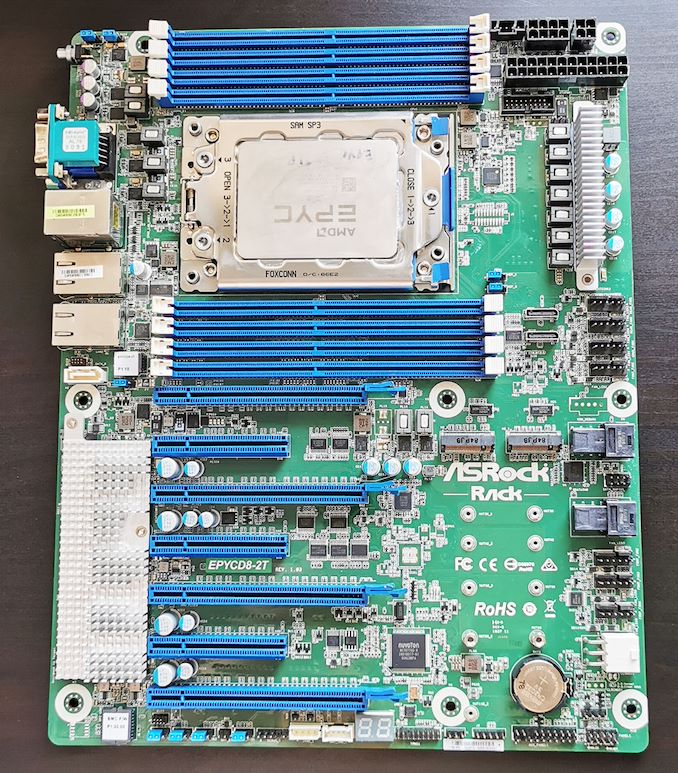
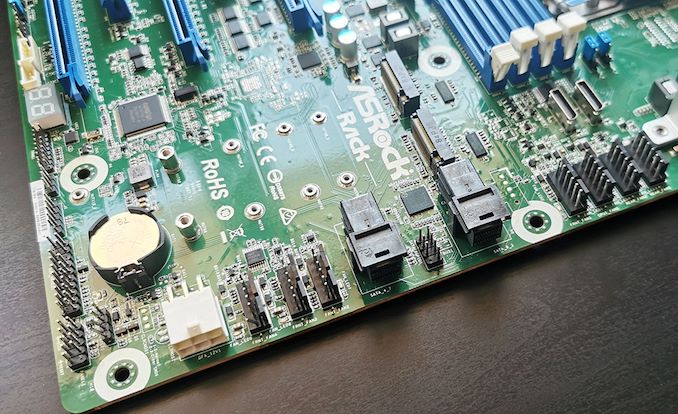
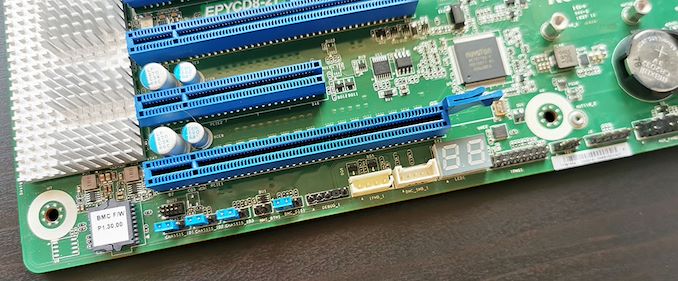
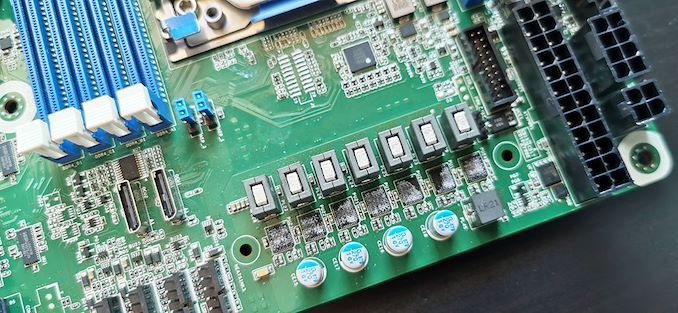

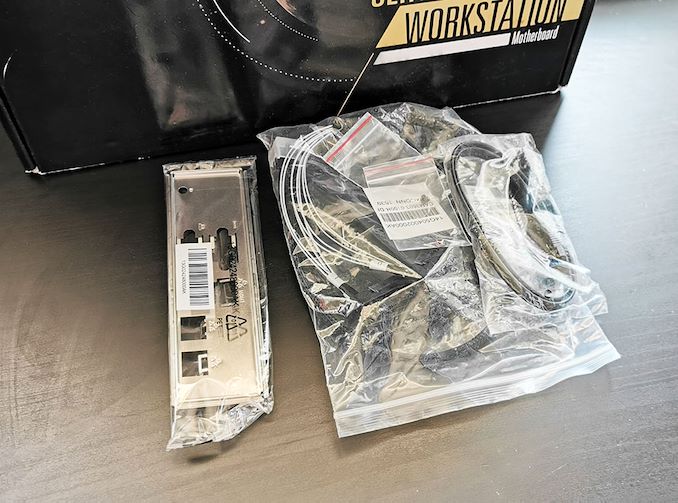








34 Comments
View All Comments
Hul8 - Monday, April 20, 2020 - link
Only a subset of reviewers found that that was the case. Some had the exact same results as long as they were running at least Windows 10 Pro.It may have more to do with running a later major version (like 1903 or 1909) than Pro versus Enterprise.
Hul8 - Monday, April 20, 2020 - link
Also, AMD explicitly stated that Pro and Enterprise are equivalent for performance, and they should know.Hul8 - Monday, April 20, 2020 - link
I think you're missing "/x16" at the end of "x16/x8/x16/x8/x16/x8". This listed litany only has 6 slots for a total of 72 lanes.MenhirMike - Monday, April 20, 2020 - link
Checking if this board supports bifurcation? The screenshot in https://www.anandtech.com/Gallery/Album/7564#7 shows a setting for the Link Width, but doesn't show the options. And even ASRock's manual only says "This allows you to select PCIE1 Link Width. The default value is [x16]"eastcoast_pete - Monday, April 20, 2020 - link
Maybe I overlooked it, but isn't this board intended for servers? If so, why not show some server-centric benchmarks? Wouldn't that be closer to the intended use case? I know that many "server" MBs are also used for workstations, but something intended for racks is less likely to end up in a workstation.AndrewJacksonZA - Monday, April 20, 2020 - link
That's quite the bent pin in Front Fan 4. What happened?dwade123 - Tuesday, April 21, 2020 - link
Junkarneberg - Wednesday, April 22, 2020 - link
This card have most of the things i need for my home studio (music produktion)But is it possible to install Thunderbolt in some way?
(thunderbolt and usb are the standards in the music industry at least the studio sound cards)
enzobozo - Thursday, May 7, 2020 - link
https://www.asrockrack.com/general/productdetail.a...thunderbolt is ready to plug in that one.
https://www.youtube.com/watch?v=Q95RlXh9BPA
https://download.asrock.com/Manual/QIG/ROMED8-2T.p...
https://download.asrock.com/Manual/ROMED8-2T.pdf
arneberg - Wednesday, April 22, 2020 - link
another question about the latency, is it low compaired with Intels mobo also, or is it only low compaired with other AMD cards.Is it the latency with the processor, or only the motherboard? the old rule was to use a intel motherboard for music-produktion. Was something with the AMD processors but that was then, now it ´s new times,